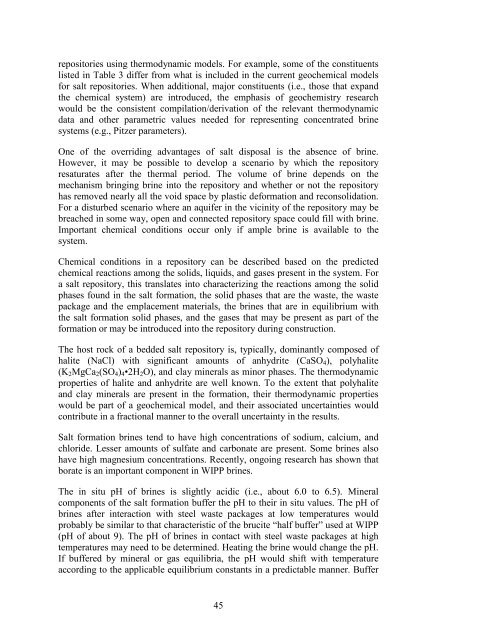Salt Disposal of Heat-Generating Nuclear Waste
Salt Disposal of Heat-Generating Nuclear Waste
Salt Disposal of Heat-Generating Nuclear Waste
Create successful ePaper yourself
Turn your PDF publications into a flip-book with our unique Google optimized e-Paper software.
epositories using thermodynamic models. For example, some <strong>of</strong> the constituents<br />
listed in Table 3 differ from what is included in the current geochemical models<br />
for salt repositories. When additional, major constituents (i.e., those that expand<br />
the chemical system) are introduced, the emphasis <strong>of</strong> geochemistry research<br />
would be the consistent compilation/derivation <strong>of</strong> the relevant thermodynamic<br />
data and other parametric values needed for representing concentrated brine<br />
systems (e.g., Pitzer parameters).<br />
One <strong>of</strong> the overriding advantages <strong>of</strong> salt disposal is the absence <strong>of</strong> brine.<br />
However, it may be possible to develop a scenario by which the repository<br />
resaturates after the thermal period. The volume <strong>of</strong> brine depends on the<br />
mechanism bringing brine into the repository and whether or not the repository<br />
has removed nearly all the void space by plastic deformation and reconsolidation.<br />
For a disturbed scenario where an aquifer in the vicinity <strong>of</strong> the repository may be<br />
breached in some way, open and connected repository space could fill with brine.<br />
Important chemical conditions occur only if ample brine is available to the<br />
system.<br />
Chemical conditions in a repository can be described based on the predicted<br />
chemical reactions among the solids, liquids, and gases present in the system. For<br />
a salt repository, this translates into characterizing the reactions among the solid<br />
phases found in the salt formation, the solid phases that are the waste, the waste<br />
package and the emplacement materials, the brines that are in equilibrium with<br />
the salt formation solid phases, and the gases that may be present as part <strong>of</strong> the<br />
formation or may be introduced into the repository during construction.<br />
The host rock <strong>of</strong> a bedded salt repository is, typically, dominantly composed <strong>of</strong><br />
halite (NaCl) with significant amounts <strong>of</strong> anhydrite (CaSO 4 ), polyhalite<br />
(K 2 MgCa 2 (SO 4 ) 4 •2H 2 O), and clay minerals as minor phases. The thermodynamic<br />
properties <strong>of</strong> halite and anhydrite are well known. To the extent that polyhalite<br />
and clay minerals are present in the formation, their thermodynamic properties<br />
would be part <strong>of</strong> a geochemical model, and their associated uncertainties would<br />
contribute in a fractional manner to the overall uncertainty in the results.<br />
<strong>Salt</strong> formation brines tend to have high concentrations <strong>of</strong> sodium, calcium, and<br />
chloride. Lesser amounts <strong>of</strong> sulfate and carbonate are present. Some brines also<br />
have high magnesium concentrations. Recently, ongoing research has shown that<br />
borate is an important component in WIPP brines.<br />
The in situ pH <strong>of</strong> brines is slightly acidic (i.e., about 6.0 to 6.5). Mineral<br />
components <strong>of</strong> the salt formation buffer the pH to their in situ values. The pH <strong>of</strong><br />
brines after interaction with steel waste packages at low temperatures would<br />
probably be similar to that characteristic <strong>of</strong> the brucite “half buffer” used at WIPP<br />
(pH <strong>of</strong> about 9). The pH <strong>of</strong> brines in contact with steel waste packages at high<br />
temperatures may need to be determined. <strong>Heat</strong>ing the brine would change the pH.<br />
If buffered by mineral or gas equilibria, the pH would shift with temperature<br />
according to the applicable equilibrium constants in a predictable manner. Buffer<br />
45
















